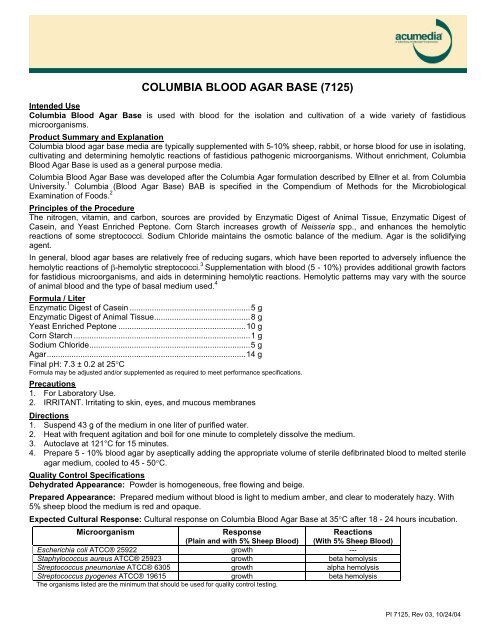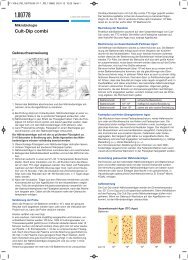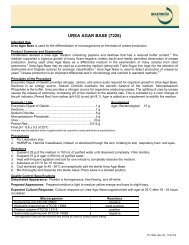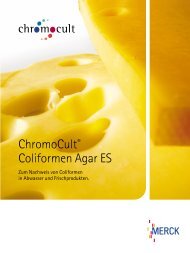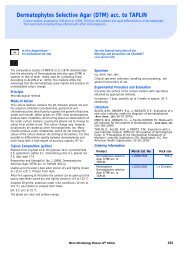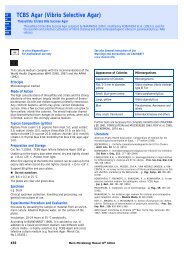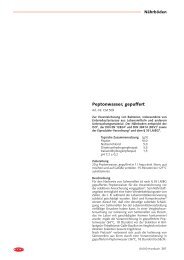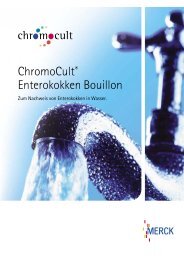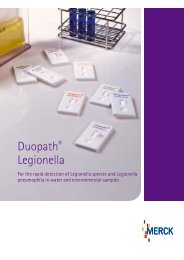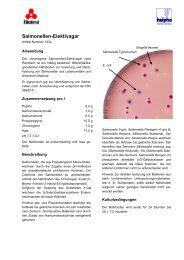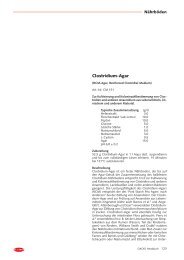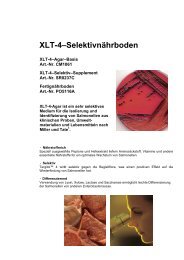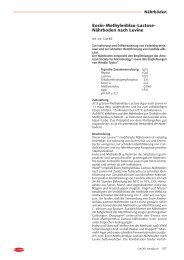Columbia Blood Agar Base (7125) - mibius
Columbia Blood Agar Base (7125) - mibius
Columbia Blood Agar Base (7125) - mibius
Create successful ePaper yourself
Turn your PDF publications into a flip-book with our unique Google optimized e-Paper software.
COLUMBIA BLOOD AGAR BASE (<strong>7125</strong>)<br />
Intended Use<br />
<strong>Columbia</strong> <strong>Blood</strong> <strong>Agar</strong> <strong>Base</strong> is used with blood for the isolation and cultivation of a wide variety of fastidious<br />
microorganisms.<br />
Product Summary and Explanation<br />
<strong>Columbia</strong> blood agar base media are typically supplemented with 5-10% sheep, rabbit, or horse blood for use in isolating,<br />
cultivating and determining hemolytic reactions of fastidious pathogenic microorganisms. Without enrichment, <strong>Columbia</strong><br />
<strong>Blood</strong> <strong>Agar</strong> <strong>Base</strong> is used as a general purpose media.<br />
<strong>Columbia</strong> <strong>Blood</strong> <strong>Agar</strong> <strong>Base</strong> was developed after the <strong>Columbia</strong> <strong>Agar</strong> formulation described by Ellner et al. from <strong>Columbia</strong><br />
University. 1 <strong>Columbia</strong> (<strong>Blood</strong> <strong>Agar</strong> <strong>Base</strong>) BAB is specified in the Compendium of Methods for the Microbiological<br />
Examination of Foods. 2<br />
Principles of the Procedure<br />
The nitrogen, vitamin, and carbon, sources are provided by Enzymatic Digest of Animal Tissue, Enzymatic Digest of<br />
Casein, and Yeast Enriched Peptone. Corn Starch increases growth of Neisseria spp., and enhances the hemolytic<br />
reactions of some streptococci. Sodium Chloride maintains the osmotic balance of the medium. <strong>Agar</strong> is the solidifying<br />
agent.<br />
In general, blood agar bases are relatively free of reducing sugars, which have been reported to adversely influence the<br />
hemolytic reactions of β-hemolytic streptococci. 3 Supplementation with blood (5 - 10%) provides additional growth factors<br />
for fastidious microorganisms, and aids in determining hemolytic reactions. Hemolytic patterns may vary with the source<br />
of animal blood and the type of basal medium used. 4<br />
Formula / Liter<br />
Enzymatic Digest of Casein ......................................................5 g<br />
Enzymatic Digest of Animal Tissue...........................................8 g<br />
Yeast Enriched Peptone .........................................................10 g<br />
Corn Starch ...............................................................................1 g<br />
Sodium Chloride........................................................................5 g<br />
<strong>Agar</strong>.........................................................................................14 g<br />
Final pH: 7.3 ± 0.2 at 25°C<br />
Formula may be adjusted and/or supplemented as required to meet performance specifications.<br />
Precautions<br />
1. For Laboratory Use.<br />
2. IRRITANT. Irritating to skin, eyes, and mucous membranes<br />
Directions<br />
1. Suspend 43 g of the medium in one liter of purified water.<br />
2. Heat with frequent agitation and boil for one minute to completely dissolve the medium.<br />
3. Autoclave at 121°C for 15 minutes.<br />
4. Prepare 5 - 10% blood agar by aseptically adding the appropriate volume of sterile defibrinated blood to melted sterile<br />
agar medium, cooled to 45 - 50°C.<br />
Quality Control Specifications<br />
Dehydrated Appearance: Powder is homogeneous, free flowing and beige.<br />
Prepared Appearance: Prepared medium without blood is light to medium amber, and clear to moderately hazy. With<br />
5% sheep blood the medium is red and opaque.<br />
Expected Cultural Response: Cultural response on <strong>Columbia</strong> <strong>Blood</strong> <strong>Agar</strong> <strong>Base</strong> at 35°C after 18 - 24 hours incubation.<br />
Microorganism<br />
Response<br />
Reactions<br />
(Plain and with 5% Sheep <strong>Blood</strong>) (With 5% Sheep <strong>Blood</strong>)<br />
Escherichia coli ATCC® 25922 growth ---<br />
Staphylococcus aureus ATCC® 25923 growth beta hemolysis<br />
Streptococcus pneumoniae ATCC® 6305 growth alpha hemolysis<br />
Streptococcus pyogenes ATCC® 19615 growth beta hemolysis<br />
The organisms listed are the minimum that should be used for quality control testing.<br />
PI <strong>7125</strong>, Rev 03, 10/24/04
Test Procedure<br />
1. Process each specimen as appropriate, and inoculate directly onto the surface of the medium. Streak for isolation<br />
with inoculating loop, and stab agar several times to deposit beta-hemolytic streptococci beneath agar surface.<br />
Subsurface growth will display the most reliable hemolytic reactions owing to the activity of both oxygen-stable and<br />
oxygen-labile streptolysins. 4<br />
2. Incubate plates aerobically, anaerobically, or under conditions of increased CO 2 (5 - 10%) in accordance with<br />
established laboratory procedures.<br />
Results<br />
Examine the medium for growth and hemolytic reactions after 18 - 24 and 48 hours incubation. There are four types of<br />
hemolysis on blood agar media described as: 5<br />
1. Alpha hemolysis (α) is the reduction of hemoglobin to methemoglobin in the medium surrounding the colony. This<br />
produces a green discoloration of the medium.<br />
2. Beta hemolysis (β) is the lysis of red blood cells, producing a clear zone surrounding the colony.<br />
3. Gamma hemolysis (γ) indicates no hemolysis. No destruction of red blood cells occurs and there is no change in the<br />
medium.<br />
4. Alpha-prime-hemolysis (α′) is a small zone of complete hemolysis that is surrounded by an area of partial lysis.<br />
Storage<br />
Store sealed bottle containing the dehydrated medium at 2 - 30°C. Once opened and recapped, place container in a low<br />
humidity environment at the same storage temperature. Protect from moisture and light by keeping container tightly<br />
closed.<br />
Expiration<br />
Refer to expiration date stamped on the container. The dehydrated medium should be discarded if not free flowing, or if<br />
appearance has changed from the original color. Expiry applies to medium in its intact container when stored as directed.<br />
Limitations of the Procedure<br />
1. Due to nutritional variation, some strains may be encountered that grow poorly or fail to grow on this medium.<br />
2. Hemolytic reactions of some strains of group D streptococci have been shown to be affected by differences in animal<br />
blood. Such strains are beta-hemolytic on horse, human, and rabbit blood agar and alpha-hemolytic on sheep blood<br />
agar. 4<br />
3. Atmosphere of incubation has been shown to influence hemolytic reactions of beta-hemolytic streptococci. 4 For<br />
optimal performance, incubate blood agar base media under increased CO 2 (5 - 10%) in accordance with established<br />
laboratory procedures.<br />
Packaging<br />
<strong>Columbia</strong> <strong>Blood</strong> <strong>Agar</strong> <strong>Base</strong> Code No. <strong>7125</strong>A 500 g<br />
<strong>7125</strong>B 2 kg<br />
<strong>7125</strong>C 10 kg<br />
References<br />
1. Ellner, P. D., C. J. Stoessel, E. Drakeford, and F. Vasi. 1966. A new culture medium for medical bacteriology. Am. J. Clin. Pathol. 45:502-504.<br />
2. Vanderzant, C., and D. F. Splittstoesser (eds.). Compendium of methods for the microbiological examination of food, 3 rd ed., p. 1113. American<br />
Public Health Association, Washington, D.C.<br />
3. Casman, E. P. 1947. A noninfusion blood agar base for neisseriae, pneumococci and streptococci. Am. J. Clin. Pathol. 17:281-289.<br />
4. Ruoff, K. L. 1995. Streptococcus, p. 299-305. In P. R. Murray, E. J. Baron, M. A. Pfaller, F. C. Tenover, and R. H. Yolken (eds.). Manual of clinical<br />
microbiology, 6 th ed. American Society for Microbiology, Washington, D. C.<br />
5. Isenberg, H. D. (ed.). 1992. Interpretation of aerobic bacterial growth on primary culture media, Clinical microbiology procedures handbook, vol. 1<br />
p. 1.61-1.67. American Society for Microbiology, Washington, D.C.<br />
Technical Information<br />
Contact Acumedia Manufacturers, Inc. for Technical Service or questions involving dehydrated culture media preparation or performance at (517)372-<br />
9200 or fax us at (517)372-2006.<br />
PI <strong>7125</strong>, Rev 03, 10/24/04


